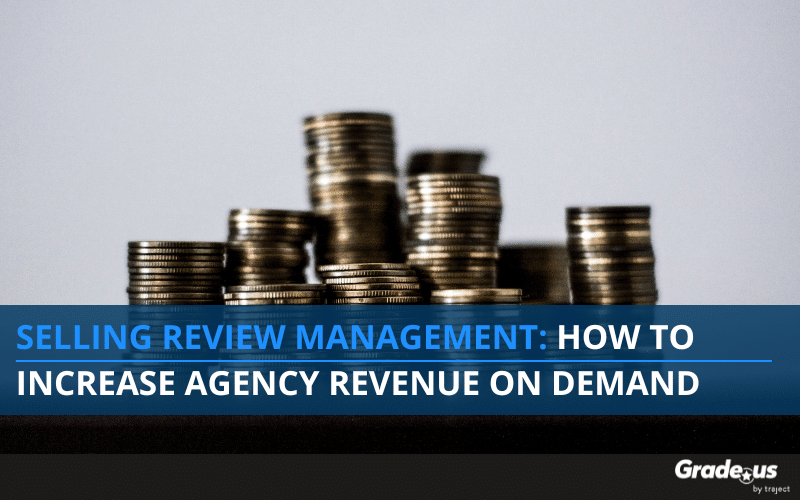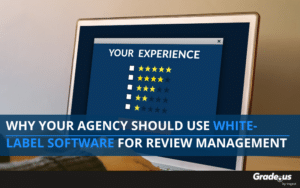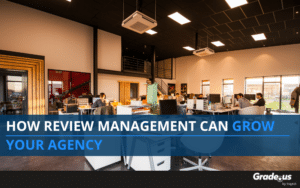Selling anything, maybe even review management, is horrible and unpleasant.
That’s the attitude many people have, isn’t it? Many people have this unspoken, subconscious belief, and there’s a good reason for that. Customers have been burned by dishonest salespeople.
This isn’t a secret.
Gallup puts ‘advertising practitioners’ and ‘used car salespeople’ at the bottom of their honesty/ethics index. Customers don’t like salespeople, and salespeople don’t enjoy selling.
Yikes. So selling is bad then?
No actually. The characteristics associated with selling – lying, manipulation, and greed – that’s bad. But that isn’t selling. So what is selling exactly? And why is it so miserable for so many customers and salespeople?
Selling is matchmaking
That’s it.
At its core, there’s really only one reason why selling is miserable for customers and salespeople.
It’s fear.
Your clients are afraid to talk to you; they’re worried you’ll pressure them into buying something they don’t want. Agency account executives are terrified of rejection; they’re afraid they’ll lose their job or fail to make the sale. Their desperation is rooted in fear.
Fear of not having enough.
Imagine you’re under a considerable amount of pressure. Your agency needs to land a new client in the next two weeks, or you’ll have to start thinking about layoffs. As of today, you only have one viable lead. You have to close that lead to avoid disaster.
What’s your state of mind?
If you’re human like the rest of us, you’re anxious, stressed out, and full of fear, am I right?
Okay then.
Same scenario. You have something your clients want. Leads.
You need to make a sale in two days only now you have…
- 63 highly qualified leads, late-stage buyers
- 15 of those people are working on signing your contract
- 7 have signed your agreement and have sent you a deposit
Now, how do you feel?
Believe it or not, the second scenario above is the outcome that defangs fear. If any one of these buyers suddenly decides to play hardball, it’s a pretty easy thing to walk away. You have plenty of ways to get the outcomes you want.
Here’s the point.
No leads, more fear
More leads, no fear
When it comes to earning agency business, your confidence is based on (at least) one of three things:
- A large volume of qualified leads
- A reliable lead source that produces leads on demand
- A proven ability to generate leads on demand
That’s it.
If you have one (or all three) of these skills, you’ll find selling is simple, easy, and inexpensive. Today, you’ll learn how to put this system to work for your agency.
What you need to increase your agency’s revenue
When it comes to increasing revenue, there are really only four clear paths you can take. These paths are tried and true, and they apply to every business.
- Win more clients
- Increase the size of each deal
- Increasing the # of transactions per client
- Raising your prices
We’ll take a systematic approach; I’ll show you how to pull on these four levers to produce the kind of revenue gains you need. Let’s look at a strategy that focuses on items one and four on our list – more clients and raising your prices.
Here’s the structure.
- Identify your breakeven point. This is the absolute bare minimum you need to cover your expenses.
- Set a low price you’re comfortable with.
- Close the clients you need to meet your breakeven point.
- Keep your clients. Double your client roster.
- Double your price for your newest clients.
- Keep your clients. Double your client roster.
- Double your price again at the end of your contract term for your newest clients.
- Repeat steps 4 – 6.
- Replace or re-up existing clients at your new rates.
Okay then.
Let’s role-play with some numbers.
- Your breakeven point: $5,000 per mo.
- Introductory price: $500 per mo.
- Clients needed: 10
What if you doubled your price per client five times?
That’s $10,000 per mo., per client.
If you keep 10 clients, that’s $100,000 per mo. or $1.2 million per year. It’s in line with what a small agency earns. These numbers won’t get you into the Forbes Top 100, but it’s a respectable start.
Here’s the thing.
You can use this structure to systematically win more clients and increase your pricing safely! This is great news because it gives you the ability to control your prices and the clients you take on. This covers items one and four in our revenue growth plan.
NOTE: Retainer, fixed rate, or hourly? Not sure which pricing model is right for you? Download our Pricing Guide.
What about items two (increasing the size of each deal), and three (more transactions per client)?
What if there was a way to earn more revenue from a small number of clients (i.e., the clients you already have)? As it turns out, the pay-per-lead model allows you to do just that.
Let me show you what I mean.
Let’s say you have three agencies. Agency A uses the retainer model, Agency B uses the pay-per-lead model, and Agency C uses both (a hybrid model).
Agency A | Agency B | Agency C |
$1K per mo. for 12 mo. | $60 per lead x 100 = $6K | $1K per mo. + $60 per lead x 100 |
Total: $12K per yr. | Total: $6K to $72K | Total: $18K to $84K (annual) |
Risk Factors | ||
High upfront cost (to client) | Inconsistent income (for agencies) | High upfront cost (to client) |
Results take time | Results outside of agency control | Results outside of agency control |
High buyer’s remorse | Agency blamed for performance | |
Increased competition (to agency) | No asset control (clients) | |
Benefits | ||
Consistent revenue (for agency) | Immediate results for clients | Immediate results for clients |
Stable revenue (for agency) | Scalable leads (for clients) | Scalable leads (for clients) |
Stable revenue (for agency) | Stable revenue (for agency) | |
Control over assets | Control over assets(?) | |
Stable growth, scalable revenue |
Can you see what’s happening?
With Agency C, a hybrid model provides them with the stability and flexibility their agency needs to grow.
- A retainer or fixed fee model gives your agency the financial breathing room you need to generate results for your clients
- The pay-per-lead model means there’s no need to chase after an endless array of clients
Using a gateway service like reputation management, you can attract, convert and grow your agency using a small number of quality clients.
Where you can go to find agency clients
It all depends on your framework. You’ll need the following ingredients if you’re looking for agency clients.
- A gateway service: You can use a variety of low-risk or low-cost services – review management, pay-per-lead, or pay-per-click, services, etc. These services are designed to get your foot in the door with a prospective client who’s able but not yet willing to buy.
- Vendors or channel partners: This can be as straightforward as relying on Google or Facebook Ads. It can also be a channel partner, an organization that’s willing to share access to their readers, customers, or list in exchange for the value that you’re willing to provide. If you’re an agency, creating content for GoDaddy, Rackspace, or AWS is a great way to generate leads.
- An irresistible offer: First 25 leads are free when you purchase 100 leads from our pay-per-lead service. An irresistible offer is clear, compelling, believable, and exclusive to your agency. Your irresistible offer answers the “why” question. Why should prospective clients choose your agency?
- A compelling promise or guarantee: This is about risk mitigation. Agencies aren’t keen on accepting risk; they’re not particularly fond of making promises to clients. The problem is trust – some clients may be predatory, eager to take advantage of your agency’s goodwill. Other clients are unreasonable; they’re unwilling to take on any risk. Agency guarantees are a promise, a gesture of goodwill that shows clients what they should expect.
Here’s an example.
Let’s say you’re an agency that’s focused on performance clients like Planet Fitness or Gold’s Gym.
- Gateway service(s): Reputation management, pay-per-lead
- Channel partners: Crossfit.com, Bodybuilding.com, EliteFTS, Weight Watchers, Jenny Craig, Hello Fresh
- Irresistible offer: 250 new members per mo. spending 25% above retail
- Promise or Guarantee: 50% of new members will sign up for membership (1 yr. minimum)
See what I mean?
When you pitch performance clients, your proposal has teeth; you can make a persuasive case outlining why they should work with your agency. You’re creating value, then working to capture a percentage of that value in your pitch.
Selling isn’t horrible or unpleasant
When it’s done well, selling is simply matchmaking. It’s identifying the right people, product, and pricing – then bringing everyone together. If clients are afraid to talk, the proper groundwork hasn’t been laid. When it’s done well, clients will be eager to talk and willing and able to buy.
When it comes to earning agency business, your confidence is based on (at least) one of three things: A large volume of qualified leads, A reliable lead source, and a proven ability to generate leads.
Use this framework to accomplish all three.
With consistent effort and a clear plan of attack, you’ll find you can increase agency revenue on command no horrible or unpleasant selling required.










